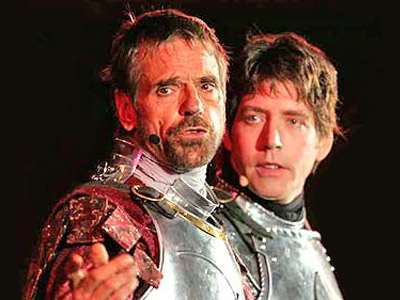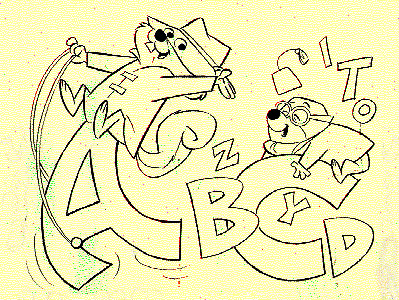
Most people probably think of Camelot as in the same category as My Fair Lady, Music Man, Oklahoma! and Guys and Dolls. That category is "Timeless Smash Hit Musicals." In truth, though Camelot now seems quite timeless, it was not a hit when it first opened in 1960. Unlike all the other shows in that category I just mentioned, reviews were mixed and audiences had a tendency to walk out well before the final curtain.
They didn't do that at My Fair Lady, the previous Broadway collaboration of director Moss Hart, writer-lyrist Alan Jay Lerner and composer Frederick Loewe. When Camelot was first advertised, audiences expected another show of the same caliber and stampeded to purchase tickets. (Lerner and Loewe had also just done the movie, Gigi, which won many Oscars including Best Picture, so that probably raised expectations further.)
But Camelot was just not as good, especially when it opened for out-of-town tryouts in Toronto. The show ran five long hours then and Lerner had a devil of a time trying to figure out how to cut it down and have it still make sense. The stress of trying to do that plus tumult from his latest semi-annual divorce, gave Lerner a bleeding ulcer and put him in the hospital.
All repair work on Camelot stopped when this happened. For weeks, the cast (headed by Richard Burton, Julie Andrews and Robert Goulet) continued to perform what all knew was a deeply-flawed script while they waited for the author to recover. Finally, the day came when Lerner was to get out the hospital and resume work. He was released a few hours early because they needed the bed for another patient…who turned out to be Moss Hart.
So now they had a writer but no director. While Hart recuperated from a major heart attack, Lerner began rewriting and also took over as director. Among his many problems was that Camelot, which was then the most expensive musical ever mounted, was a nightmare of huge sets and costumes. Lerner would later say that the show was overwhelmed by its pageantry; that it was hard to find and fix the story amidst it all. In an article he wrote several years after, he mentioned one smart thing he did just before the show opened on Broadway…
Fearing the intimacy had been lost, I called a full dress rehearsal without the "dress" part. I insisted that the actors wear their street clothes, even to the extent of ordering several who arrived on stage in costume to change back to civvies. I also ordered the crew to keep the set changes as simple as possible, creating more of a rehearsal hall ambience on the stage. The result was the most moving, personal performance of Camelot and the one I best remember. When we resumed work with the sets and wardrobe, much of that intimacy was lost and we all regretted that audiences could not experience the show as we had in that rehearsal.
Camelot, sets and all, opened on Broadway on December 3, 1960. If unknowns had been behind it, it might not have lasted a week. But the reps of Lerner, Loewe and Hart had sold enough advance tickets that it was destined to run at least six months, during which two "miracles" (as Lerner called them) occurred. One was that Hart, released from that Toronto hospital, came to see it and helped Lerner to do a significant rewrite. Shows rarely change much after they open but in this case, Camelot was said to be substantially improved. This is the version performed ever since.
Then came the second miracle: Ed Sullivan, who then had the most popular show on TV, devoted an entire program to the works of Lerner and Loewe. (This miracle may have been aided by the fact that the show was on CBS, and CBS had financed Camelot.) At the time, current Broadway shows rarely "gave away" their best moments on television, on the theory that audiences wouldn't pay after experiencing them for free. Camelot had nothing to lose so they did all the best songs on the Sullivan show and the next morning, the box office finally had a line of ticket buyers befitting a smash hit.
Soon after, there was a third miracle, albeit one born of tragedy. Everyone felt that the first act of Camelot was stronger than the second but after the assassination of President Kennedy, that changed. The connect of Kennedy and Camelot was dodgy but it was strong enough to alter the play's impact for many. As Lerner wrote, "Ever since that day in Dallas, the ending has taken on new meaning. God knows I would have preferred that History had not become my collaborator."
All of this is the lead-up to a brief review of what I saw Sunday evening: A one-performance, "concert-style" production of Camelot at the Hollywood Bowl. Jeremy Irons played King Arthur, Melissa Errico was Guenevere, Paxton Whitehead portrayed Sir Pellinore, James Barbour performed the role of Lancelot, Orson Bean did Merlyn, Malcolm Gets was Mordred and they had a fine supporting cast helping fill the stage.
The result was a wonderful performance…easily the best of the several Camelots I've seen. That would include the major revival with Richard Harris who, though he'd then been doing the play for months, forgot more of his lines than did Mr. Irons, who learned his for the one night.
Irons was fantastic — a little rough on the tunes, but so fine in the non-singing parts that you could forgive the missed notes. The whole cast was excellent and I got the feeling that this modest staging — with simple yet elegant costuming and no sets — may have approximated that "street clothes" performance that Lerner so loved. It surely had the same result. The play was truly about the relationship of Arthur, Guenevere and Lancelot, rather than about the scenery. I don't recall being moved much by previous viewings of Camelot but last night, there were several moments — the ending, especially — that got to me, and made that canyon-like Hollywood Bowl arena feel small and intimate.
Gordon Hunt directed…and I'm sorry his efforts all went for just one performance because it was a wonderful one. Late in life, Alan Jay Lerner occasionally toyed with the idea of reviving Camelot in a "simpler" version so that audiences could see and feel what the play he wrote was really about. He never got around to that, so I'm glad Gordon did it for him. And for us.


